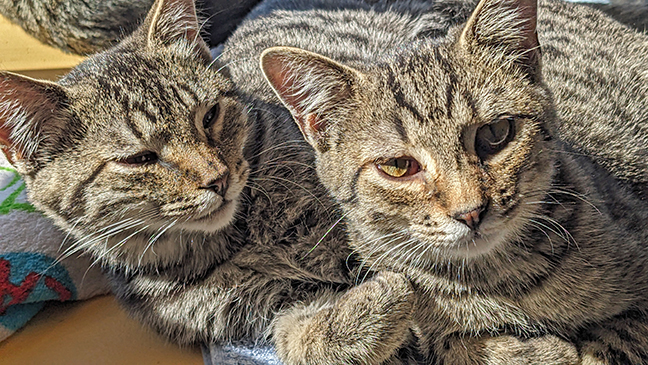
19 Oct Second Chance: For the Love of Tabby Cats, Stripes, Spots & Swirls!
Second Chance Humane Society’s Animal Resource Center (SCHS) and Thrift Shops have been serving San Miguel, Ouray and Montrose Counties since 1994. The shelter is open to the public Tuesday through Saturday 11am – 5:30pm. Community veterinary services are available by appointment.
View shelter pets and services online: www.adoptmountainpets.org.
Go here for more options from Second Chance.

Tabby is the most common pattern for cats’ coats. The gene for the tabby pattern can be found in all domestic cats. (Look at a black cat in the sun, and you may see hidden tabby markings.) A tabby refers to a cat who has a pattern of stripes, swirls, spots, or blotches of colors. They can be various shades of brown, grey, or ginger with darker stripes or patterns. It is believed the name “tabby” comes from a type of striped silk called Atabi, which was made in Attabiah in the Middle East.
All tabbies have thin lines on their faces, expressive markings around the eyes, and a distinct letter “M” on their foreheads. If your tabby sheds, you will notice that individual hairs have dark roots. These are called agouti hairs and feature alternating light and dark segments.
These similarities don’t mean all tabbies are the same. There is a wide variety of patterns and colors within tabbies. The four main patterns are mackerel, classic/blotched, spotted, and ticked.
Mackerel tabbies have stripes of dark fur running vertically along their bodies. These stripes can be uninterrupted or divided up along the stomach and flanks. Mackerel tabbies are also referred to as fishbone tabbies and are the most common type.
Blotched tabbies, also referred to as classic or marbled, have a combination of circles, swirls, and stripes on their bodies.
Spotted tabbies, as the name suggests, have spots on their sides and backs. The number, size, and spacing of these spots vary.
Ticked tabbies have a gradient of color in each fur follicle, with a lighter shade at the base and a darker color at the tip. Their body may not look patterned, but they have distinct markings on their faces and legs.
When it comes to personality, many owners seem to think there is something special about a tabby. Some believe tabbies are the most outgoing cat of all, playing and exploring like no other. Others think their tabby cat shows higher intelligence than other felines.
If you are in search of a “mouse exterminator,” a tabby may be your best friend. Tabbies are hunters by nature, which may be a benefit of their tabby patterns assisting to camouflage when hiding in tall grass or brush hunting for prey. Tigers and leopards both have tabby patterns.

All this information is shared to encourage people to adopt a tabby cat! We have so many grey tabby kittens and young cats who are waiting for their forever homes. Stop by the shelter and visit Wednesday to Sunday from 11 a.m. to 5:30 p.m.
AND… To continue the Second Chance Highlights section, we want to share the following:
The Importance of Foster Volunteers:
One way we can open more space in the shelter is to place pets in foster homes. Foster placement can be a few days, a few weeks, or until the pet is adopted. Candidates for fostering often have issues that are better tackled in a home such as illness or injury, stress, or inability to adjust to a group situation. Puppies and kittens who are too young to be in a shelter, or nursing mothers and their litters are best cared for in foster homes. Sometimes a pet just needs a break from shelter life. Our wonderful fosters have been instrumental in allowing a pet to be their true self by relaxing, exploring, and meeting people in the community.
The process of becoming a foster volunteer involves completing a foster application and having a home visit to confirm that your home is safe and secure for a foster pet. It’s a great way to have the love of a pet in your home without making a long-term commitment.
Being a foster volunteer is both challenging and extremely rewarding. The challenge comes from bringing a new pet into your home and working through the adjustment period. The reward is knowing you are giving the pet a chance to heal and trust so that they can be more quickly placed into a forever home. Second Chance provides all the food, medications, and supplies needed for the duration of the foster period.
Pet Pantry Stats
August Pet Pantry:
We served 17 families in August. This included about 23 cats, 3 cat colonies (1 with over 30+ cats), and 20 dogs. We served families in Ridgway (2), Montrose County (10), Ouray County (3), Nucla (1), and Hinsdale (1).
September Pet Pantry:
We served 24 families in the month of September. This fed about 45 cats, one cat colony, and 40 dogs. Of the families served 19 were in Montrose County, 3 were in Ouray County, 1 was in Delta County, and 1 was in Hinsdale County.
Partners who donated to the pantry in August & September:
8/9: Target 8/10: Walmart 8/31: Target
9/18: Walmart 9/23: Chow Down


Sorry, the comment form is closed at this time.